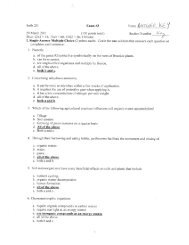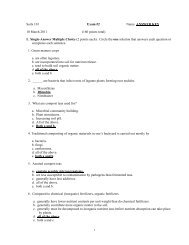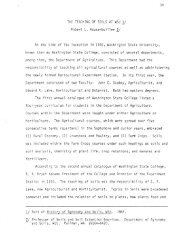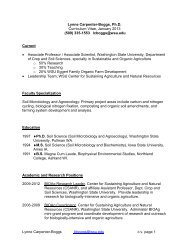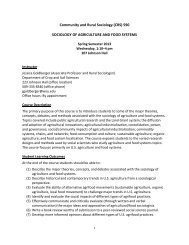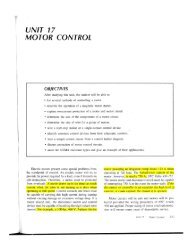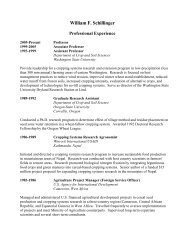2012 Dryland Field Day Abstracts - Dept. of Crop and Soil Sciences ...
2012 Dryland Field Day Abstracts - Dept. of Crop and Soil Sciences ...
2012 Dryland Field Day Abstracts - Dept. of Crop and Soil Sciences ...
Create successful ePaper yourself
Turn your PDF publications into a flip-book with our unique Google optimized e-Paper software.
Part 2. Pathology <strong>and</strong> Entomology Page 37<br />
alternative host plants for both the virus <strong>and</strong> aphid.<br />
Email listservs are used to alert farmers <strong>and</strong> crop consultants <strong>of</strong> aphid infestations <strong>and</strong> whether they carry virus – which greatly<br />
influences potential damage to legume crops <strong>and</strong> the aphid population levels at which growers should apply insecticide. This<br />
information is also posted to the Aphid Tracker website at http://www.cals.uidaho.edu/aphidtracker/index.asp.<br />
2) Decision Tools: We have developed the first research-based economic injury level for pea aphid in pea crops on the Palouse. In<br />
addition, 5 years <strong>of</strong> field survey results were used to estimate the spatially variable character <strong>of</strong> disease prevalence on the<br />
l<strong>and</strong>scape, as well as a region-wide estimation <strong>of</strong> aphid density based on historical meteorological data <strong>and</strong> an index <strong>of</strong> aphid<br />
abundance from 1986-2006. These elements have been incorporated into online tools to help producers decide about seed<br />
treatments <strong>and</strong> early season sprays for aphid control.<br />
Online calculators have been constructed from these data:<br />
The first calculator helps growers decide on treatments for pea seed.<br />
The second calculator helps growers decide whether to spray their fields early for aphid.<br />
The third calculates an Economic Injury Level for aphids pre-bloom.<br />
3) Accelerated Breeding for Virus Resistance in Pea <strong>and</strong> Lentil: Plant breeders at North Dakota State University are developing pea<br />
<strong>and</strong> lentil varieties with resistance to PEMV <strong>and</strong> BLRV, using marker-assisted selection to augment the breeding process. They are<br />
also improving diagnostic tools that verify virus presence <strong>and</strong> disease reaction. These varieties will be useful additions to<br />
forecasting <strong>and</strong> decision tools to help reduce the severity <strong>of</strong> virus outbreaks.<br />
Mutation Breeding <strong>of</strong> Cultivated Barley <strong>and</strong> Screening <strong>of</strong> Wild Barley for Resistance to Rhizoctonia<br />
Root Rot<br />
O. Ajayi, S. Ullrich, T. Paulitz, K. Campbell <strong>and</strong> K. Murphy; <strong>Dept</strong>. <strong>of</strong> <strong>Crop</strong> <strong>and</strong> <strong>Soil</strong> <strong>Sciences</strong>, WSU <strong>and</strong> USDA-ARS<br />
Rhizoctonia root rot <strong>and</strong> bare-patch caused by Rhizoctonia solani G-8 is one <strong>of</strong> the most important diseases that limit crop yields in<br />
no-till/direct seeding systems in the Pacific Northwest (PNW), <strong>and</strong> in turn, limiting the widespread adoption <strong>of</strong> this system in this<br />
region. But in the PNW, spring cropping with no-till/direct seeding <strong>of</strong>fers a potentially better approach to increasing cropping<br />
intensity <strong>and</strong> circumventing the negative impacts tillage has on the environment, mainly on soil <strong>and</strong> water due to erosion. However<br />
for spring barley, an important rotational crop with winter wheat, peas <strong>and</strong> lentils, Rhizoctonia root rot appears to be the most<br />
important disease under direct seeding systems. The role <strong>of</strong> barley as a rotational crop highlights the possibility for its use in<br />
managing the disease if resistant barley cultivars are included in the normal 2-3 year rotations with winter wheat under reduced<br />
tillage in any growing environment. Furthermore, it has been shown that barley in rotation with winter wheat improves the<br />
productivity <strong>of</strong> winter wheat. Therefore, the objective <strong>of</strong> our research is to identify potential sources <strong>of</strong> resistance to R. solani AG-<br />
8 in barley. Since there is no known resistance in the natural populations <strong>of</strong> barley available to breeders, we employed two<br />
approaches to achieve the set objective. Firstly, we employed induced mutation as a means <strong>of</strong> creating new genetic variation. The<br />
first experiment involved screening sodium azide barley mutants for disease reaction to R. solani AG-8, verifying the resistance in<br />
putative mutants, <strong>and</strong> carrying out genetic analysis to determine the mode <strong>of</strong> inheritance <strong>of</strong> resistance to the pathogen. Ten<br />
putative M3 individuals from 2 different barley lines, 05WA-316.99 <strong>and</strong> ‘Lenetah’ have been verified for resistance <strong>and</strong> crosses have<br />
been made to the wild type to begin inheritance studies. Secondly, given the importance <strong>of</strong> wild crop relatives to crop<br />
improvement, our second experiment involved exploring the possibility <strong>of</strong> identifying resistance to the disease in the direct<br />
progenitor <strong>of</strong> cultivated barley Hordeum vulgare subsp. spontaneum. Of the entire pool <strong>of</strong> 316 accessions in the Wild Barley<br />
Diversity Collection that was screened for resistance, 6 accessions showed potential as gene donors for Rhizoctonia resistance with<br />
one accession, WBDC 021 showing the greatest potential based on the disease ratings <strong>and</strong> other growth parameters measured.<br />
Further testing is currently being carried out to verify the resistance <strong>of</strong> these accessions to R. solani AG-8 <strong>and</strong> also to R. oryzae,<br />
another pathogen known to cause root rot <strong>of</strong> wheat <strong>and</strong> barley <strong>and</strong> found with R. solani AG-8 in production fields. The overall goal<br />
is to release resistant barley cultivars to farmers in the PNW, thereby, providing a more sustainable <strong>and</strong> environmentally sound<br />
means <strong>of</strong> managing the disease.




